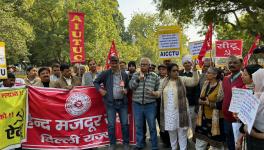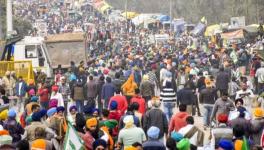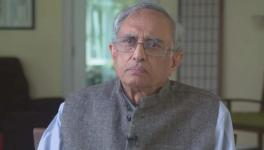Why Indian Farmers Cannot Afford to Call off their Protest
More than a month has passed since the unfortunate incidents at the tractor rally of farmers on 26 January. However, we should not forget that the farmers were not allowed to enter the capital on the route which they had initially proposed.
It was argued that the “public” of this country cannot enter the capital during the Republic Day parade. The mismanagement by the administration and police which followed is known to everyone. But the question this incident poses is: Is there no value of physical labour or the working class for our government? Is agriculture not a skill like other jobs, for example, engineering and the medical profession?
The farmers have endured the extreme cold of January and February, now are they bound to face Delhi’s extreme heat in May and June too?
What is the way out of India’s agrarian crisis? Minimum Support Price is a major demand, but it is not the ultimate solution to farmers’ problems. To stop farmer suicides, the government needs to increase its agricultural budget and redistribute land. However, since Independence, whatever development programs the government has undertaken, have focused on cities and the villages have been left impoverished.
If as a result of this discrimination people from villages march to the capital city to demand what is their due, what is wrong with it? Even in cities, development is focused on the upper-middle and upper classes, which supports the government in its actions against farmers and other poor and deprived classes. Corporate media adds fuel to the fire. In cities too, factory workers rarely, if ever, get the minimum wages. Domestic workers have no law to protect them and other workers in the unorganised sector, who form the majority of our working population, are leading a truly horrible life.
When these toiling masses raise their voice against exploitation, they are labelled as “Naxals”, “Khalistanis” and anti-nationals.
The miserable conditions in villages force the poor small and marginal farmers to migrate to cities, but here too they face inhumane working conditions. Separated from their families, with no job security and unimaginable living conditions, they are afflicted by depression and confront the scourge of alcoholism. In these, too, the elite classes find an excuse to ridicule them.
Workers in cities face a shocking lack of water supply, electricity, sanitation, health, education, and every other basic service and facility. Workers’ unions have been destroyed by dividing the workers into four groups: the majority are contract workers, completely dependent on the whims and fancies of contractors; daily-wage earners, direct company employees who are a minority; and permanent workers employed in government-owned industries.
The last category of work is, at best, a minuscule minority of the working class of our country. Hence, the vast majority of workers are forced to live a precarious lifestyle.
Factory workers get no opportunity to avail the health benefits provided in government hospitals because they barely get any time out of their 16X7 work schedules. Hence, they are forced to visit private hospitals where they can save time by avoiding having to stand in never-ending queues. But in these hospitals, they have to spend their hard-earned money to avail themselves even rudimentary health services.
The government is least interested in constructing hospitals and schools. Instead, it allows even land meant for agriculture to build so-called special economic zones, shopping malls, and multi-storied apartments meant for the elites. This increases the unemployment in the countryside and reduces agricultural output.
It is shameful that an agrarian country like India has to import food grains from abroad! The acquisition of agricultural land by builders has destroyed many farmers and even those few who have got compensation are now facing a serious economic crisis, such as the Jats and Gujjars of Uttar Pradesh, the Patidars of Gujarat, and the Marathas of Maharashtra. This is the reason why agricultural communities are demanding reservation in government jobs for the youth.
Successive governments have completely avoided the villages and labour-intensive agriculture.
In the First Five Year Plan (1951-56), only 14.9% of the budget was allocated to agriculture which fell to 5.2% in the Tenth Five Year Plan (2002-2007). On the other hand, the capital-intensive policy of agricultural development in the form of the Green Revolution led to further problems in Indian agriculture including in the so-called prosperous states of Punjab, Haryana, and the western region of Uttar Pradesh. As a result of the so-called Green Revolution, agricultural productivity was affected and the contribution of agriculture to gross domestic product decreased a lot. In 1947, agriculture’s contribution to the GDP was 65% which is now less than 10% whereas around 60% of the population still depends on agriculture.
According to scholars such as P Sainath, 50% of Indian farmers are caught in the debt cycle. Andhra Pradesh tops this list with 82% of the peasantry indebted. After this are Tamil Nadu, Punjab, Karnataka, and Maharashtra where 74.5%, 65.4%, 61.6%, and 54.7% of peasants are respectively in debt. This is the real reason why farmers commit suicide.
In 2007, the then Agriculture Minister Sharad Pawar accepted in Parliament that 1,00,248 farmers had committed suicide from 1993 to 2003. However, according to non-government sources, between 1991-2006, 1.5 lakh farmers committed suicide.
Since 1947, agriculture has been called an “unskilled” occupation by the government of India and the income of peasants and workers has been reduced drastically while capital is diverted to industrial and urban projects. Even the industrial development did not benefit the farmers. It is only the income of the elite classes that increased manifold. The result is that the average rate of a farmer’s labour is just Rs.30 a day whereas according to MNREGA, even an unskilled labour’s income is fixed at Rs. 60 and the salary of a peon, clerk, teacher, professor, collector, and so-called people’s representatives are fixed at Rs. 210, Rs. 350, Rs. 1,500 and Rs. 2,500 daily. (Data from Dr. Darshan Pal’s book, Bharat ka Krishi Sankat—India’s Farm Crisis).
Uneven distribution of land is another serious issue. Even after six decades of Independence, maximum land is occupied by elite landowning classes. The government introduced a land ceiling but it was not implemented properly. Bihar, Jharkhand, Uttar Pradesh, Chhattisgarh, and other states have many landowners who own thousands of acres of land. Many of them are absentee landlords. They have built huge “farm houses” and invested capital in plantation agriculture. Many religious institutions and trusts have occupied lakhs of acres of land too.
Redistribution of land is an immediate need to increase the income of the majority of Indian farmers. Secondly, the government needs to increase its agricultural budget to reduce the cost of production for the farmers. The coming days will reveal the farmer's plans and how they plan to intensify their agitation against the three farm bills and for MSP. The government needs to take action to solve the agrarian crisis if India is to march on the path to peace and prosperity.
The author is an independent journalist. The views are personal.
Get the latest reports & analysis with people's perspective on Protests, movements & deep analytical videos, discussions of the current affairs in your Telegram app. Subscribe to NewsClick's Telegram channel & get Real-Time updates on stories, as they get published on our website.
























